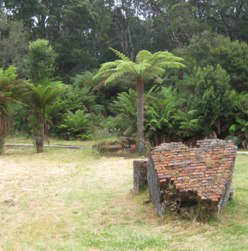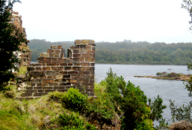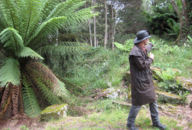SARAH ISLAND
Macquarie harbour, Strahan, Tasmania
December 23, 2007


SARAH ISLAND
Macquarie harbour, Strahan, Tasmania
December 23, 2007




Convicts from England were shipped to Australia where they did their “time” for theft, forgery, embezzlement, larceny or fraud, mostly what we call “white collar” crimes today. There was a very high literacy rate amongst the Australian prisoners. If these convicts talked about escape, dared to offend a guard, if they refused to work or were insubordinate, or committed any other minor (or major) offense while working off their time in Australia, they were then sent to Sarah Island in Tasmania. This tiny island in Macquarie Harbour, just past Hell’s Gate, was a penal colony of slave labor. The prison had a reputation for corporal punishment in the form of lashings using the cruel instrument called “The Cat of Nine Tails”. For example, 9,100 lashes given in the year 1823 under the command of Commandant Cuthbertson, a “bully with peculiar qualities”. The island hosted scores of people, including prisoners, military guards and their families, plus a doctor, a chaplain, and a commandant, who managed the community. A few nurses lived on a tiny adjacent island, Grummet Island, which was later turned into a prison for the hardened criminals of Sarah Island, especially prisoners who committed murder, or tried to escape. At one point there were 78 men living in one cave on this tiny bit of land. In 1828, records show that 89 men slept in three rooms of the new penitentiary building on Sarah Island itself, 84 in the older building next door. The men were not locked in these prisons. Some slept in hammocks, others in bedding they spread on the floor. We were guided through the brick ruins of this ex-penal colony by an actor/guide who re-enacted stories about life on this island, and told tales of some of the more infamous prisoners. Many prisoners attempted to escape; some were successful. One prisoner was re-imprisoned, having been re-captured two years after his escape. He left the island with four of his buddies, but returned with only two. The two absent friends had become protein for the other three. Convicts at Sarah Island were put to work building boats, using the Huon Pine timber that was floated down the Gordon River for this purpose. The pine trees produce an oil which protects the timber from fire or rot, ideal for use in the building of ships. In 1829, under the command of Commandant Butler, ship building increased. Flagellations decreased dramatically, while solitary confinement increased. Butler used incentives of tobacco and rum to reward good behavior. Toward the end of its history, we were told that imprisonment on Sarah Island became an unusual adventure where a petty criminal could learn the ship building trade. After serving his incarcerated apprenticeship, he would have a job waiting in Hobart, at the shipbuilding works owned by the island’s Commandant. In all, the prisoners built 170 ships during the life of this prison. I might add one postscript. The last ship built on Sarah Island sailed away with a crew of convicts. All of them were returned from Chile, where they had landed. These sailors were tried in Hobart, some of whom were found guilty of mutiny.
PHOTOS: Upper Left: View of Sarah Island in the harbor. Lower Left: View from the island. Center: A ruin of the area where four small buildings once stood. These housed the doctor and prison administrators. The heart-shape is a lucky accident, revealed only after downloading. Is there a message in this symbol? Upper Right: Ruin of the prison, actually a dormitory for prisoners, without locks. Lower Right: Our Guide, and actor who brought the island’s stories to life.


Notorious 19th Century Prison

